

Lesson planning is a political act. Schools in the US, at the core, are designed to promote a monocultural and monolingual perspective of teaching and learning. As educators, the lessons we create and facilitate either support or dismantle educational systems that have historically marginalized specific student communities (Medina and Izquierdo, 2021). Black and Indigenous students of color (BISoC); language learners; children with specific academic, behavioral, and/or physical health needs; and students belonging to the LGBTQ2S+ community, among others, have been deprioritized in a schooling system that is centered on “Whiteness” and heteronormative ideologies and aligned with privilege resulting from English monolingualism. Educators can move away from this ideology through carefully planned content, language, and culture learning targets to ensure students actively engage with grade-level expectations while co-constructing a culturally and linguistically inclusive educational experience.
Since its release in 2018, the C6 Biliteracy Instructional Framework (C6BIF) has been embraced by schools and districts providing dual language, bilingual, world language, ESL/ENL/ELD/EAL, and English monolingual programming throughout the US and abroad. The framework embraces everything educators bring into the classroom in terms of pedagogical expertise and aligns the lesson-planning processes to the latest biliteracy instructional recommendations. In addition, educators and administrators seeking to scale culturally and linguistically sustaining pedagogical practices appreciate the flexibility of the framework, which allows them to put research into action using a critical consciousness lens to break down oppressive educational systems. Ultimately, the goal is to ensure these invaluable practices are replicable in every school environment.While Guiding Principles for Dual Language Education: Third Edition (Howard et al., 2018), often referred to as the GP3, promotes culturally and linguistically sustaining biliteracy instructional practices that allow educators to better serve diverse student communities, it does not explicitly identify how the research recommendations should be incorporated into an educator’s everyday lesson planning. The C6BIF is conceptualized to align with the GP3 and beyond and to engage in the important work of critical consciousness and anti-bias/anti-racism in the pre-K–12 classroom. This article, organized into four sections and concluding with recommendations, explores the impact of daily integration of content, language, and culture learning targets to allow for this critical work to occur through the lesson-planning process:
- The Need for Critical Consciousness in Lesson Planning
- The C6BIF as a Vehicle for Action
- Content, Language, and Culture Learning Targets as a Foundation for Critical Consciousness Work
- Moving beyond Performative Equity Work
The Need for Critical Consciousness in Lesson Planning
Schooling systems were conceptualized to promote a White, monolingual, heteronormative, patriarchal, and often xenophobic teaching and learning perspective. Currently, state legislators in the US are working to deny educators the ability to facilitate accurate historical lessons. Targeted pre-K–12 topics include but are not limited to the origins of slavery, the Holocaust, the LGBTQ2S+ community, and American Indian/Alaska Native history, which relate to individuals in the populations most marginalized in schools. This, coupled with the increasing number of books banned from school libraries for amplifying actual events in history, makes it imperative that educators leverage the lesson-planning process to ensure anti-bias and anti-racism work is at the center of every lesson designed.
In Pedagogy of the Oppressed, Paulo Freire (2005) informs the reader that pedagogy must be forged with, and not for, those who are oppressed. The oppressed, the students as part of a schooling system that has historically “othered” them, must actively engage in constructing their learning and their liberation. This is critical consciousness. When lesson planning uses this lens, educators do not seek to be the voice for students. They instead seek to dismantle the systems that mute student voices. It is essential to acknowledge our inherent participation in student oppression due to an alignment with past antiquated and potentially biased educational practices. However, as educators, we can offer reparation for the trauma that has been inflicted on our most diverse student communities by how we choose to engage in the lesson-planning process and by leveraging content, language, and culture learning targets.
The C6BIF as a Vehicle for Action
In conceptualizing a lesson-planning framework specifically via a biliteracy instructional lens, it was imperative to identify culturally and linguistically sustaining systems that would support critical consciousness recommendations. Additionally, C6BIF alignment with the three dual language programming goals, including bilingualism/biliteracy, grade-level academic achievement in two program languages, and an overt focus on sociocultural competence and critical consciousness, was equally important (Arias and Medina, 2020). The intersection of these concepts resulted in the six components of the C6BIF, each designed to house biliteracy instructional systems that would be replicable in any educational setting and to empower students to be co-creators of the instruction and learning that takes place in the classroom. The C6BIF is not a checklist or a to-do list. Instead, it is a way of thinking about the lessons we plan and identifying how they are or are not creating a pathway for all students to access grade-level standards through a critical consciousness lens. Whatever professional learning educators have engaged in, it has a home within the C6BIF.
Planning for content, language, and culture learning targets is the first step to ensuring that we enable students to collaborate within each lesson’s teaching and learning construct. When we do so, student ownership of what happens in every task becomes a reality, as they are integral to the learning process. Figure 1 depicts the six components of the C6BIF, including the descriptors and identifiers for each element of the framework.
Beginning with create, planning for content, language, and culture learning targets is the first step in empowering students to own their entire identities and deeper learning. Additionally, educators can simultaneously disarm educational systems designed to continue the oppression of BISoCs.
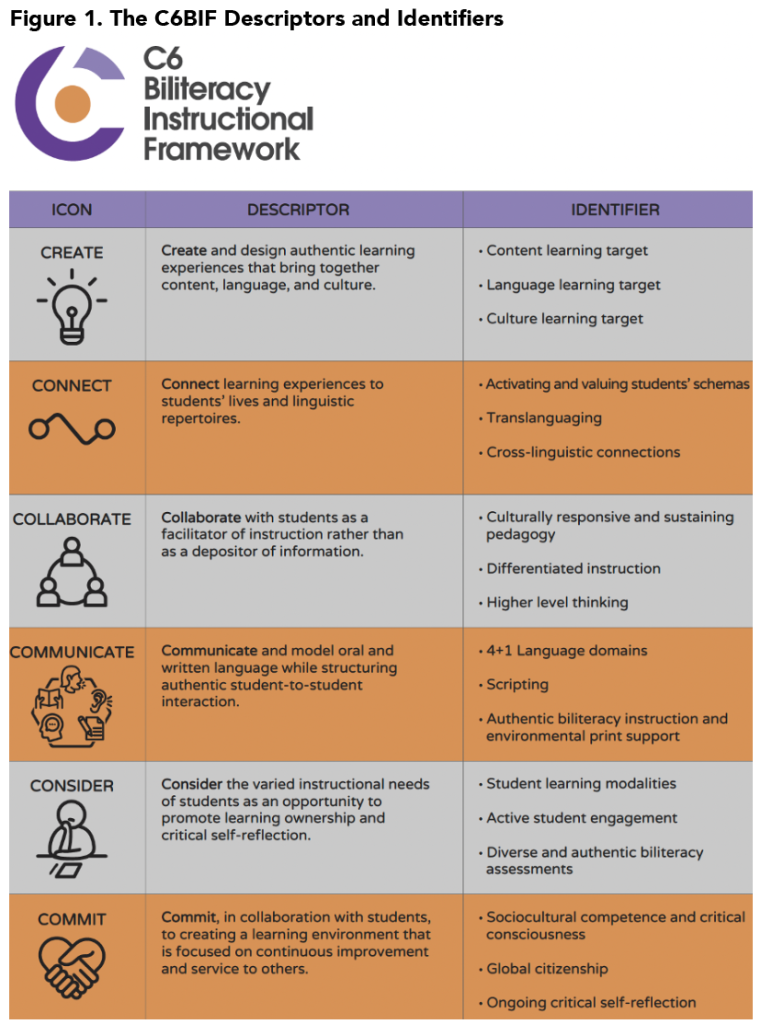
Content, Language, and Culture Learning Targets as a Foundation for Equity Work
As pre-K–12 educators, we must create and design learning experiences that bring together content, language, and culture (Medina, 2020). From a student ownership perspective, planning for content, language, and culture learning targets eliminates antiquated ideologies focused on compliance. Instead, we acknowledge that schooling systems may require us to share our lesson plans with administrative leaders, but that should never supersede our most crucial job—using learning targets to co-construct meaning alongside students in the classroom.
Most educators feel comfortable unpacking grade-level standards. After all, this is the focus of state education agencies and university departments who dictate what content must be taught. When we participate in educator preparation programs or engage in alternative educator certification routes, we are charged with teaching specific standards deemed appropriate for certain age groups. However, less prevalent is the opportunity to fully understand the role that language and culture learning targets have in ensuring that students access the content shared. When we fail to leverage them through strategic planning, we align with systems that continue to oppress marginalized student communities.
Content Learning Targets
Moss and Brookhart (2012) inform readers that “the most effective teaching and the most meaningful student learning happens when educators design the right learning target for today’s lesson and use it with their students to aim for and assess understanding.” In reviewing the literature on learning targets and their importance, much is focused on the benefits of lesson planning for the educator. However, lesson planning via an educator lens excludes the student’s equal co-participation in the learning experience. The two identified researchers move away from this paradigm and instead place students front and center as active participants in the interaction with learning targets.
Planning instructional objectives guides the instruction that we as educators will facilitate. However, planning for learning targets from the students’ point of view drives student learning and ownership.
By unpacking the grade-level standards from a student perspective, educators invite students into a learning space that has often viewed them as visitors to, rather than owners of, the classroom. With what seems a simple shift in focus, educators can begin the monumental process of liberation in the classroom. Student ownership of the learning is a nonnegotiable when lesson planning through a perspective that centers on critical consciousness. By having full access to the pedagogical systems in the classroom, pre-K–12 students become active participants in an educational journey for and about them. Student ownership disrupts the status quo and causes desmadre or “good trouble.”
Most adults cannot imagine driving to a new destination without entering the destination address in the Waze app. Waze guides the driving experience by offering route options, signaling possible obstacles, and predicting expected arrival times as part of the drive.
It helps individuals on their journeys to their destinations. In the same way, students must own their journeys into new learning. Whether using the Common Core State Standards (CCSS), the Texas Essential Knowledge and Skills (TEKS), the Standards of Learning (SOL), or the Alaska Standards (AS), the content learning target provides that opportunity.
When the content learning targets posted for students begin with CCSS 1.2478934678xyz9 or TEKS 10.247d3x397, it is a tell-tale sign that they are intended for the adults in the school. Unfortunately, many teachers continue to post content learning targets precisely as the state agencies write the standards. Learning targets should be written in language that is age-appropriate for the students and will signal to them what will be learned, the process that will guide the learning, and what outcomes will be expected of them as part of the lesson engagement. Content learning targets do not water down the standards but rather amplify their effect so that students can access, manipulate, reflect upon, and own them.
It is recommended that content-, language-, and culture learning targets are shared at least three times during a lesson. This is true for all students but especially important for BISoCs and students adding languages to their linguistic repertoires. It is helpful to share them at the beginning of a lesson to ensure active engagement and total commitment on the part of the students as they enter the learning process, as a quick review mid-lesson to serve as a formative check in terms of lesson ownership, and at the end of a lesson as a final connection with the content learning target. In addition, this gives students the ability to reflect on whether they have accessed the grade-level standards or if additional work must occur.
Ultimately, posting and sharing learning targets are a pedagogical system, but without full student ownership, the system becomes meaningless. Students must actively post, review, assess, and modify learning targets alongside the educator during each lesson. Only then can the power of learning targets be fully unleashed. As we lesson plan for what the students will learn, the following are considerations that help guide the work:
- Plan for content learning targets through the students’ perspective to guide learning and ownership.
- Create learning targets that disrupt the status quo and reject a monolingual- and monocultural-centric perspective of teaching and learning.
- Design rigorous student-friendly content learning targets aligned with CCSS, TEKS, SOL, or AS recommendations.
- Post learning targets in the language of instruction in dual language, bilingual, and world language settings; do so in color aligned with the program language.
- Use visuals and gestures to clarify learning targets for early childhood classrooms.
- Plan and have students share/review learning targets at the beginning, middle, and end of each lesson.
- Leverage resources that align with school and district initiatives to unpack and differentiate the planning of content learning targets. These may include:
- Bloom/Anderson/Krathwohl’s Taxonomy
- Webb’s Depth of Knowledge
- Understanding by Design’s Six Facets of Understanding
- The Taxonomy of Significant Learning
- Marzano and Kendall’s Taxonomy
- Use language starters that align with the school and district’s pedagogical systems when planning and posting learning targets. For example, with learning targets focused on student ownership, language starters may include but are not limited to:
- I can…
- I will be able to…
- Students will be able to…
- We are learning to…
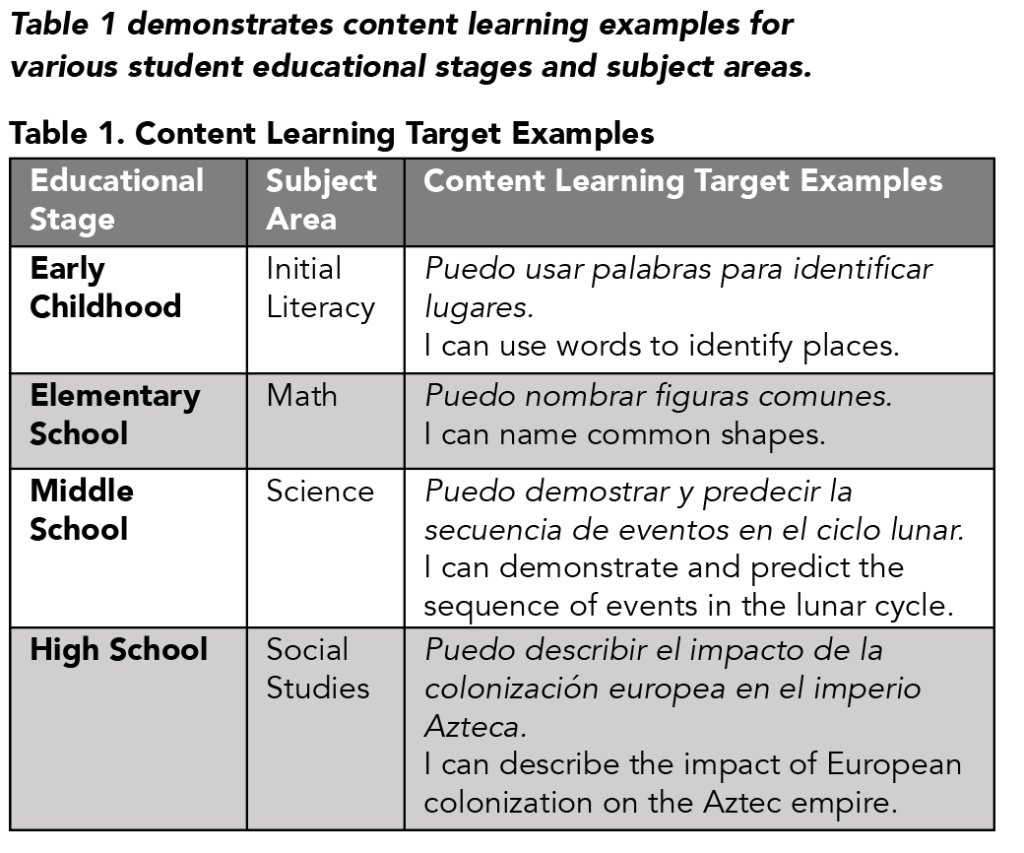
Language learning targets
As educators, we tend to feel comfortable in lesson planning for content learning targets because, historically, that has been the primary focus of our work. However, we tend to be less agile in planning for language learning targets that consider the linguistic demands that students will need to maneuver as they interact with content instruction (Medina, 2020). Moreover, the lack of clarity around language learning target systems complicates matters for educators trying to create access to grade-level standards by including the linguistic needs of the students (Medina, 2021). If biliteracy instructional systems exclude language learning targets as foundational, then educational entities fail to scale the biliteracy practices (Medina and Izquierdo, 2021b).
Language learning targets and how students will access the standards via listening, speaking, reading, writing, and metalinguistic awareness are the linguistic equity part of the lesson-planning process. When unpacking language learning targets, it is helpful to envision a set of heavy metal doors; the doors are locked and cannot easily be opened. Behind the closed doors are the grade-level standards.
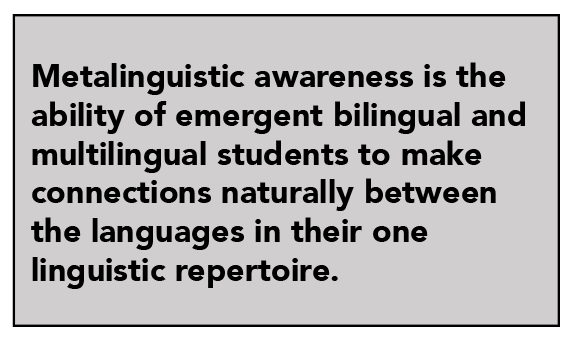
The language learning target planned by educators and owned by students is the key that opens the doors to content learning targets. When asking students to engage with content without providing a language learning target as a key to open the doors, educators ask them to find the standard in the dark. At that moment, educators become linguistic oppressors. To systematize the planning of language learning targets, there are three specific components for educators to consider using in their classrooms:

- 4+1 language domains (Figure 2) provide a visual and tactile, linguistically sustaining system to promote student ownership of language learning targets. The icons represent the listening, speaking, reading, writing, and metalinguistic awareness language domains and are used by students throughout each lesson to fully interact with the content learning target.
- Metalinguistic awareness is the ability of emergent bilingual and multilingual students to make connections naturally between the languages in their one linguistic repertoire.
- Often, and specifically in US classrooms, metalinguistic awareness has been ignored, and it has rarely been leveraged by an educational system that centers on English monolingualism.
- Simplified language learning targets (Table 2) provide a three-step system for planning language learning targets.
- Step 1: Choose an action verb connected to the 4+1 language domains. Although students may utilize all language domains during a lesson, plan for the one or two language domains that students should focus on to access the content standards. When serving early childhood students, visuals are a helpful scaffold.
- Step 2: Make an explicit connection to the content learning target. This step is not intended to repeat the content learning target but rather an opportunity for the student to quickly connect with the standard.
- Step 3: Include a student interaction to further create access to the content learning target. The interaction can be with a partner, group, graphic organizer, language frame/starter, whiteboard, technology application, text, image, song, video, or other tool.
- Detailed language learning targets (Table 2) create an opportunity to add a fourth step to the simplified language learning target, allowing students to further engage with and extend their content and language learning.
Echevarría, Vogt, and Short (2014) initially identified four ways to provide linguistic support.
By adapting their work to include a specific focus on bilingualism and biliteracy, educators can lesson plan to leverage students’ full linguistic capabilities and promote linguistic liberation through the detailed language learning target.
The four ways are:
- Academic vocabulary: There is no hierarchy among languages, only context. All language is equally valid and vital to the human experience. However, school settings require academic language, including content-specific vocabulary, as part of teaching and learning. We must navigate this nebulous space and expose students to various registers while continuing to create linguistically inclusive spaces. Moreover, bilingual and dual language settings utilize two program languages, empowering students to engage in rich cross-linguistic work that embraces their multilingual identity.
- Language skills and functions: As linguistically diverse students engage with the 4+1 language domains, they must do so by fully leveraging their entire linguistic repertoires. When students are expected to language for specific purposes (e.g., compare, contrast, defend, summarize, sequence, analyze, critique, etc.), adding a fourth step to the simplified language learning target supports them in using their linguistic dexterity.
- Language structures or grammar: Emergent bilingual and multilingual students must engage in a constant negotiation between the languages they mobilize. Different language structures, grammar patterns, and other orthographic differences and similarities between the program languages offer students opportunities for contrastive analysis. A detailed language learning target promotes this essential part of student ownership of content and language learning.
- Language learning strategies: For students who leverage multiple languages, language learning strategies go beyond self-monitoring; they focus on languaging their deep content understanding in more than one language. Student understanding of bilingualism and biliteracy is imperative, and the detailed language learning target offers extended support for this work.
Table 2 shows simplified and detailed language learning target examples for various student educational stages and subject areas. The first three steps in each example represent the simplified language learning target. The fourth step identified and shaded in green can be added to transform the simplified language learning target into a detailed language learning target.
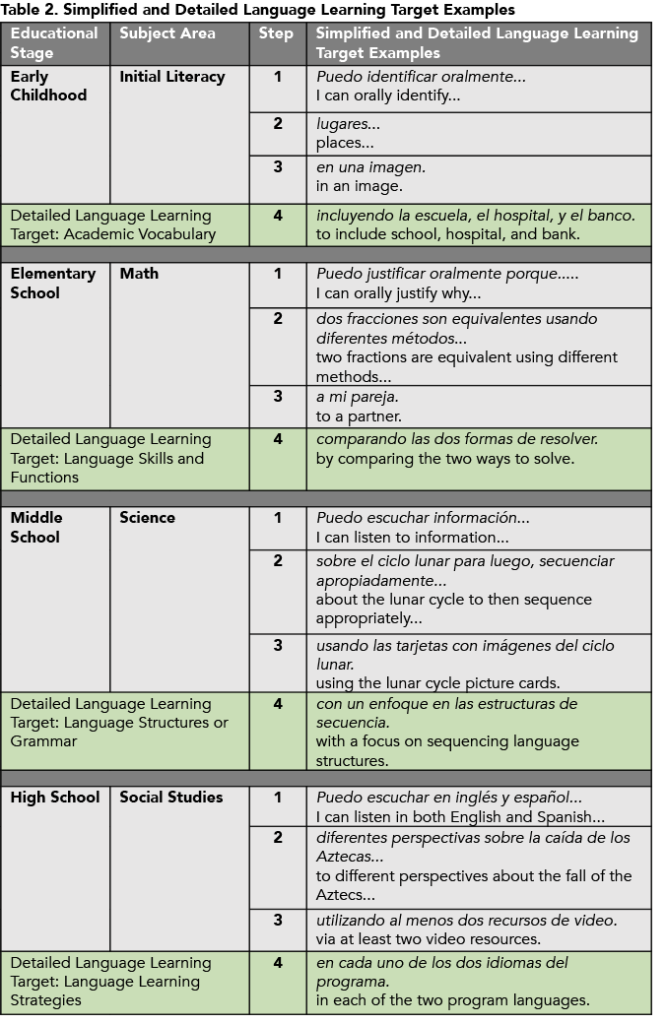
Culture Learning Targets
Introduced by Howard, Sugarman, and Coburn (2006), culture learning targets initially focused on supporting cross-cultural awareness as a component in dual language programming. Although the intent was to relate content to varied cultural groups within and outside the classroom, the use of culture learning targets in most classrooms was sporadic. It lacked specificity in terms of lesson planning.
The C6BIF amplifies the purpose for culture learning targets by providing context and the why for the content and language learning targets. In addition, culture learning targets were strengthened to dismantle systems of oppression through every lesson planned. With a continued focus on sociocultural competence and critical consciousness as the foundation of dual language programs, the C6BIF and specifically the culture learning target is now leveraged in classrooms globally to engage in and support anti-bias and anti-racism work. Whether in a monolingual, bilingual, dual language, ESL/EAL/ENL/ELD, or world language setting, the culture learning target provides a pedagogical system to contextualize and integrate content, language, and culture learning.
It is intimidating for any educator to tackle issues that can be considered taboo in educational settings. This is especially true as some state legislatures consider bills with an intent to erase historical events and silence specific communities by excluding them from pre-K–12 classroom learning; these include the civil rights movement, the murder of American Indian/Alaska Native communities, gender inequity issues, and topics affecting the LGBTQ2S+ community. Culture learning targets support educators to engage in this work, in a systematic fashion, alongside the student.
Culture learning targets allow educators to chip away at systems that oppress culturally and linguistically diverse student communities with every lesson planned and facilitated. The C6BIF clarifies four specific ways, as shown in Table 3, to prepare for culture learning targets and ensure that students are engaged in sociocultural competence and critical consciousness work.
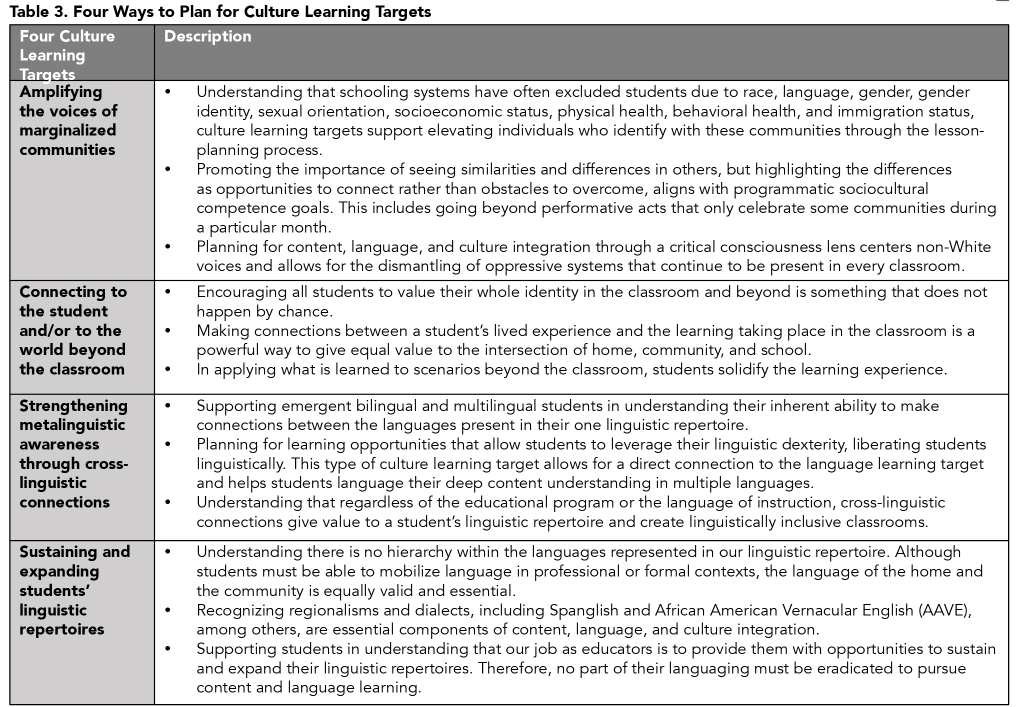
Moving Beyond Performative Equity Work
When we acknowledge and accept that schooling systems in the US and abroad were conceptualized to promote a White, monolingual, and monocultural perspective of teaching and learning, we must be critically reflective about how we are or are not dismantling oppressive education systems. Our intentions as educators must go beyond the performative.
From the moment we enter educator preparation or alternative certification programs, the pedagogy shared with us is most likely aligned with the perspective that we must teach students rather than learn alongside them. We may be instructed to see students as having gaps, identifying which children are “high” or “low,” and target student language that needs improvement rather than embracing an asset-based perspective of student abilities.
As educators, we understand empathy is needed to support students from marginalized communities. However, being good people and having compassion is not enough if we are not challenging the systems that continue to other students who are not White-adjacent enough. When we believe that some students do not have “what they need” to succeed in schools, we align with outdated ideologies that exclude non-White student communities from what happens in the classroom. Celebrating communities during one observed month a year is not equity work.
Ultimately, these are uncertain times that require bold actions. Lesson planning as a political act requires us to leverage content, language, and culture learning targets as the primary way to engage the students we serve, and ourselves, in anti-bias and anti-racism work daily.
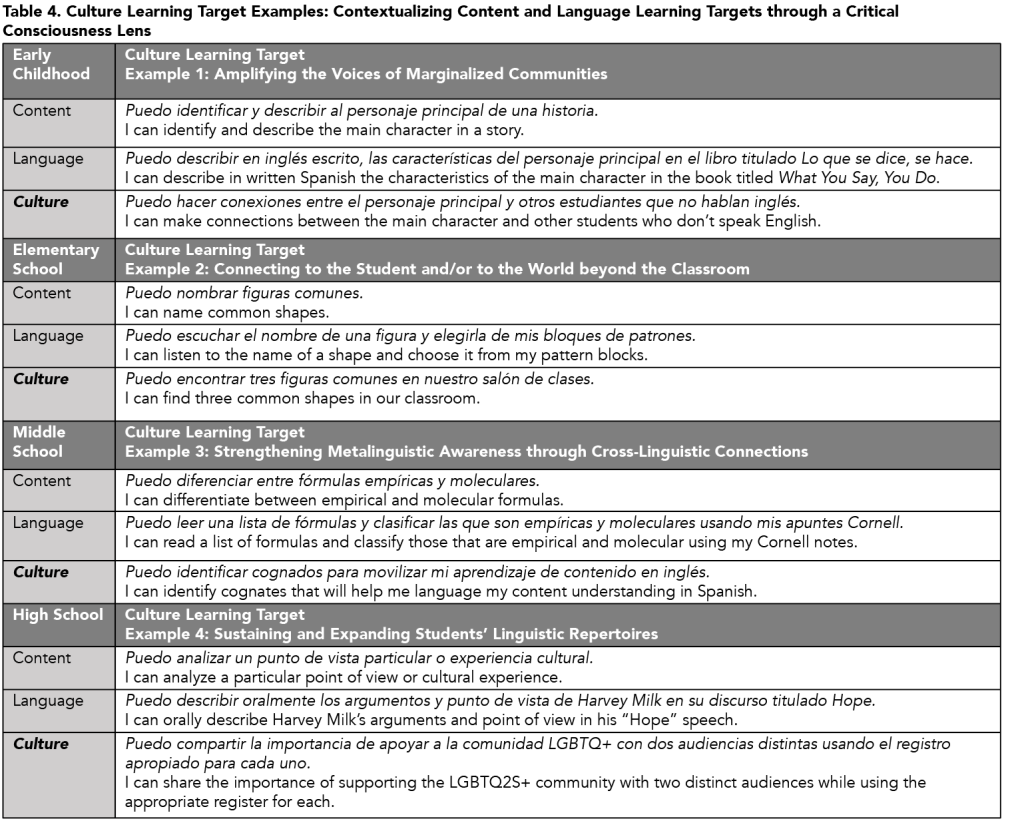
Recommendations
As discussed throughout this article, content, language, and culture learning targets provide the roadmap to ensure our critical consciousness work is strategically embedded into every lesson we facilitate alongside the students we are charged to serve.
The educator and the student can work together to activate the lesson-planning process, leading to comprehensive critical consciousness work that will positively impact a student’s educational experience. The following are recommendations to facilitate meaningful change:
Self-reflection. As educators, we must be willing to look in the mirror and identify our conscious and unconscious biases; we all have them, and they are inevitably a part of our lesson-planning process. However, when we genuinely want to take a role in comprehensive critical consciousness work and support students in learning, educators must confront our past experiences and understand that they helped shape our belief systems, including how we input and disseminate information within educational settings.
Willingness to learn and unlearn. Once our biases are identified, we must be willing to unlearn them to evolve as human beings and educators. Like many other behaviors described throughout this article, unlearning conscious and unconscious biases will take time and dedication while we change the bedrock of our inherent programming. The first step is to acknowledge that we are not immune to bias. Leveraging the lesson-planning process, specifically content, language, and culture learning targets, as a primary tool to emerge from culturally and linguistically destructive pedagogical practices is vital in this journey.
Empowering the student. Brené Brown states in her book Atlas of the Heart that we must “believe what people share with us, as empathy without believing the individual diminishes the person’s experience with us” (Brown, 2022). To truly become a meaningful collaborator, the student needs to understand their role in the lesson-planning process and take full ownership of their content, language, and culture learning. It is also critical that the student believes that we truly value their unique story and fully accept their cultural and linguistic repertoires as integral components of the classroom environment.
Continuous tenacity and engagement. A primary mistake that we can make as educators is to believe that critical consciousness work can be accomplished in one lesson, one conversation, one activity, or interacting with one text or read-aloud. Nothing could be further from the truth. It is ongoing foundational work to learn alongside students and empower them to be active participants in the educational process. Integrating content, language, and culture learning targets is a vehicle to do so. We must stand firm in our decision to dismantle educational systems that continue to cradle a monolingual and monocultural perspective of teaching and learning. Desmadre in the name of equidad and social justice does not come easily, but it is the only way.
References available at www.languagemagazine.com/references-medina-aug-2022.
Dr. José Medina is a language researcher and dual language expert supporting school districts serving diverse student communities in the US and abroad. Presently, he is part of the E3: Equity, Efficacy, and Evidence research team engaged in a six-year longitudinal study focused on scaling biliteracy instructional practices. The first serialization rights of Dr. José Medina’s C6 Biliteracy Instructional Framework have been granted to Language Magazine by Velazquez Press, a division of Academic Learning Company, LLC. Copyright Dr. José Medina







